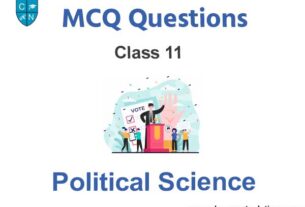Please refer to MCQ Questions Sociology and Society for Chapter 1 Class 11 Sociology given below. All MCQ questions are provided with answers. These MCQ Questions for Class 11 Sociology are designed based on the chapters given in your CBSE NCERT Textbook for Class 11 Sociology. These MCQ Questions are expected to come in your class 11 Board exams.
Question. Distinct from government and business, civil society can be understood as:
A. The “third sector” of society
B. The “watch dog” of Society
C. The “curator” of society
D. The “guardian” of society
Answer
A
Question. With whom among the following are the concepts universalization and parochrialisation associated?
A. Robert R. Marret
B. McKim Marriott
C. R. Redfield
D. Meyer Fortes
Answer
B
Question. Which is the peasant movement of India mobilized by Gandhi?
A. Champaran Movement
B. Baradoli Movement
C. Kheda Movement
D. Mappilla Movement
Answer
A
Question. Cultural traits are acquired through-
A. Learning
B. Imitation
C. Socialization
D. Contact
Answer
C
Question. The agency that is expected to play the three roles of a watchdog, scorekeeper and gatekeeper in contemporary society is:
A. Media
B. Opposition parties
C. Police
D. Intelligence agencies
Answer
A
Question. Satya Shodhak Samaj was founded by
A. Tilak
B. Ranade
C. Raja Ram Mohan Roy
D. Jyotiba Phule
Answer
D
Question. Who facilitated the Appko Movement in Uttara Kannada district of Karnataka?
A. Manjunath Hegde
B. Sishir Hegde
C. Pandurang Hegde
D. Santosh Hegde
Answer
C
Question. Which one of the following is NOT a feature of modernization process?
A. Increasing commercial activities
B. Social control on kinship basis
C. Increasing division of labour
D. Increasing social complexity
Answer
B
Question. Suppression, regulation and prohibition of visual and audio matter in media that people consider as offensive and obscene is termed as:
A. Social censorship
B. Cultural censorship
C. Ethical censorship
D. Moral censorship
Answer
D
Question. Who among the following sociologists has considered purity and pollution as the primary characteristic of the caste system?
A. L. Dumont
B. G.S. Ghurye
C. M.N. Srinivas
D. A.M. Hocart
Answer
A
Question. Who said that the four Varna division is not a vertical, but a horizontal one with all castes placed on equal footing?
A. M. N. Srinivas.
B. M.K. Gandhi
C. B.R. Ambedkar
D. G.S. Ghurye
Answer
B
Question. The theories which assume that all societies follow the same path, evolving from simple to complex through uniform sequences are known as:
A. Unilinear theories
B. Evolutionary theories
C. Uniform theories
D. Sequential theories
Answer
A
Question. An aggregate of non-governmental organizations and institutions that manifest and act for furthering the interests and will of citizens is known as:
A. Mass media
B. Civil society
C. Interest group
D. Pressure group
Answer
B
Question. A.R. Desai Social change refers to change in-
A. Structure of society
B. Size of society
C. Density of society
D. Life style in Society
Answer
A
Question. The form of media which probes deeply into a topic of interest, such as serious crimes, political corruption or corporate wrongdoing is known as
A. Crime media
B. Probe media
C. Investigative media
D. Responsible media
Answer
C
Question. A large numbers of people, who, through deliberate and sustained efforts, organize themselves to promote the interest of a particular section or a common cause of society represent:
A. A social movement
B. A social revolution
C. A social transformation
D. A social process
Answer
A
Question. Who differentiated two approaches to the study if Indian society as the Book View and the Field View?
A. M. Panini
B. M.N. Srinivas
B. Louis Dumont
D. A.R. Desai
Answer
B
Question. Which of the following tribes initiated the Jharkhand Movement?
A. Bhils
B. Bodos
C. Santals
D. Nagas
Answer
C
Question. There are two types of newspapers, Broadsheets and:
A. Tabloids
B. Pamphlets
C. Magazines
D. Dailies
Answer
A
Question. Which one of the following impacts of globalization on relative deprivation is true?
A. Relative deprivation disappeared
B. Relative deprivation increased
C. Relative deprivation decreased
D. There is no impact on relative deprivation
Answer
B
Question. An increase in the earth’s temperature due to the greenhouse effect is known as:
A. Global degradation
B. Global decay
C. Global distress
D. Global warming
Answer
D
Question. A world system in which we use our physical environment and natural resources to meet the just needs of humanity and leave an enriched environment to the next generation is called:
A. Responsible environment
B. Sound environment
C. Sustainable environment
D. Enlightened environment
Answer
C
Question. Modernity as concept in Sociology is understood as:
A. A Fashion
B. A way of life
C. A subculture
D. A perspective
Answer
B
Question. Who wrote the Book “Homo Hirearchicus”?
A. Louis Dumont
B. Henry Maine
C. Nicholas Dirks
D. J.H. Hutton
Answer
A
Question. Civil society organizations work for
A. Economic growth
B. Segmental growth
C. Inclusive growth
D. Exclusive growth
Answer
C
Question. Which one of the following is NOT one of the stages of a social movement identified by Sociologists?
A. Initial unrest and agitation
B. Disorganization
C. Resource mobilization
D. Institutionalization
Answer
B
Question. Arrange the following media in descending order as source of news in India
A. Television-Radio-Social Media-Newspaper
B. Television-Social Media-Newspaper-Radio
C. Social Media-Television-Newspaper-Radio
D. Newspaper-Social Media-Television-Radio
Answer
B
Question. Who among the following originally used the term ‘Relative Deprivation’?
A. Samuel A. Stouffer
B. R.K. Merton
C. W.G. Sumner
D. A. Henderson
Answer
A
Question. Who is of the opinion that, nothing can emancipate the outcastes except the destruction of the caste system?
A. H. Risley
B. A.R. Desai
C. M.K. Gandhi
D. B.R. Ambedkar
Answer
D
Question. The birth and growth of the U.S. Civil Rights Movement during the 1960s can be an example of:
A. Deprivation Theory
B. Structural strain theory
C. Resource mobilization theory
D. New age theory
Answer
B


